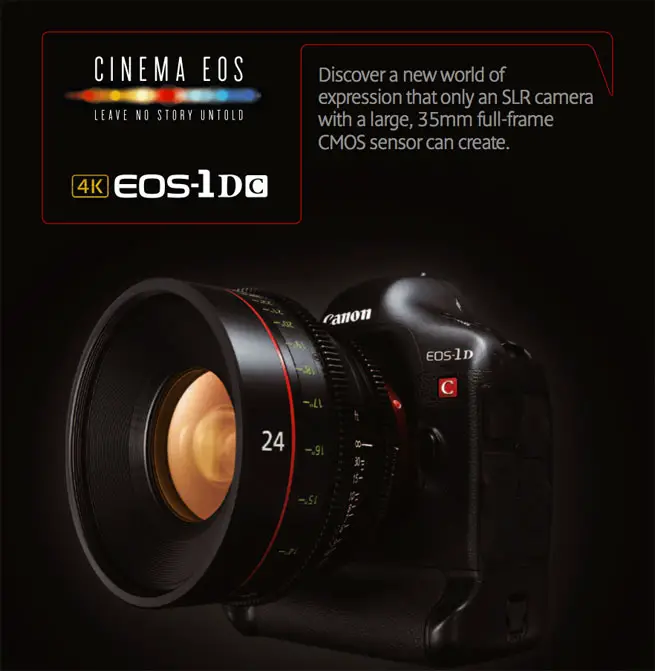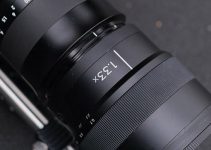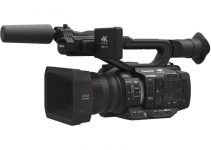The Canon EOS-1DC has been around since March 2013, and more or less, has not been the hit Canon were hoping for. Proudly sporting the “1″ nomenclature in its name and a full-frame sensor, the 1DC at the time of its release, was the world’s 1st DSLR to shoot 4K video. It was the first step Canon made towards some sort of a “hybrid” line between a stills camera and a motion picture camera.
Since then it has been, and still is, Canon’s top end DSLR for video. The “1-series” have always been Canon’s flagships in the photography world. However, the 1DC is a bit of a strange beast, and at times often a neglected option for 4K video.
The Canon 5D Mark II was unveiled in late 2008 and quickly became a hit thanks to its Full HD video capable 35mm full-frame sensor feature, making it effectively the 1st Generation video DSLR. It’s no coincidence that Canon took their sweet time and didn’t release its successor the even more capable 5D Mark III in 2012, almost four years later. During this time the 5D Mark IIs were selling fast and in good numbers.

Expectations were running high, ever since it was first announced in April 2012, so when it finally hit the shelves at around the $10,000 mark in early 2013, the film and video production community were not thrilled. Not that we were expecting a sub-$5,000 4K DSLR in 2012, but the premium price tag put the 1DC out of the hands of most of the people it was intended for to begin with.
Canon’s marketing strategy has been rather confusing at times and is generally considered reactive as opposed to forward thinking. However, Canon saw the opportunity to sell more stills cameras by providing them with HD video capabilities after the 5D Mark II’s popularity, and they decided to basically re-brand their top end stills model – the 1D X, by adding some advanced (for the time) video features. It did produce some incredible images though. Check out mini-doc below shot by Philip Bloom on the Canon EOS-1DC.
4 inches of ice from Philip Bloom on Vimeo.
On the page, it sounds like a great idea. However, the reality is that the 1D X, and by default, the 1DC (note: the C is for Cinema) is a very heavy and bulky DSLR. The double-sided battery grip makes it almost impossible to rig for video use without resorting to some “Franken”-rig or adding even more bulk to an already heavy body. Which meant, you had to use the 1DC mainly on a tripod in a heavily rigged configuration. What made the 5D Mark II so attractive was portability, you could shoot hand-held and with a minimal rig. The 1DC is a real hog, not only in terms of size and weight, but also in terms of data rates.
Canon chose the massive MJPEG (Motion JPEG) for video the 4K compression inside the EOS-1DC. At nearly 3.6GB per minute, MJPEG is not a very efficient codec for compression, which meant one was going to need massive storage capacity to store and back-up that 4K footage, as well as a fast machine to edit it on.
However, for some reason at the time Canon thought it was the most appropriate codec for them to use on the 1DC. Sure, it did a good job at minimizing artifacts such as aliasing and moire, and at 4K certainly it resolves a more resolution than the H.264 in the 5D Mark II at 1080p, and despite the improved image quality, the codec was just too massive to handle by the masses.
One important thing to note about the 4K MJPEG codec on the 1DC is that it is an Intra-frame codec – where all frames are recorded individually, as opposed to an “inter” frame codec, where certain frames are grouped together for efficiency reasons. It can produce stunning images and has amazing low light sensitivity as evidenced by the video below shot by James Miller:
Canon 1DC 4k | Test Clip at 3200 ISO | Zeiss ZF F/1.4 at F/2 from James Miller on Vimeo.
Nearly two years after the Canon EOS-1DC, we have a much more efficient 4K compression in the form of XAVC and H.265. The former currently residing on the new generation of 4K cameras such as the SONY PMW-F55, the Panasonic Lumix GH4, and the soon to be released Sony A7s (which sports the XAVC-S variant of XAVC, but more on that in upcoming articles).
The Canon 1DC might have not caught on as the 5D Mark II did before it, but it is certainly a very capable camera if you take into account the internal 4K codec requirements, the size, and the price tag. Had it been priced at around the $5-6K mark, it would have probably sold better and been adopted further by the filmmaking world. But hey, it did give way to the Canon C300.
It would be certainly interesting to see some tests between the 1DC and the new crop of 4K DSLR’s – the Sony A7s or the GH4 soon. We’ll be sure to keep you updated on those as they come in.
Disclaimer: As an Amazon Associate partner and participant in B&H and Adorama Affiliate programmes, we earn a small comission from each purchase made through the affiliate links listed above at no additional cost to you.
Claim your copy of DAVINCI RESOLVE - SIMPLIFIED COURSE with 50% off! Get Instant Access!





ditto. And not just dynamic range, but still captures, showing grain structure and how film like the organic digital noise is in the 1DC
The 1DC does indeed have a pleasant grain structure, but it’s due a refresh IMHO, hope to see a version 2.0 , or at least part of the 1DC DNA into the new 7D Mark II. Come IBC we’ll probably hear something from Canon, hopefully.